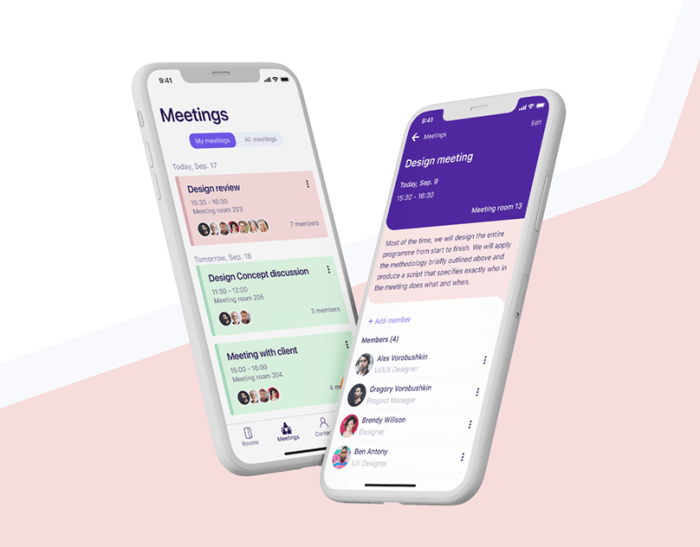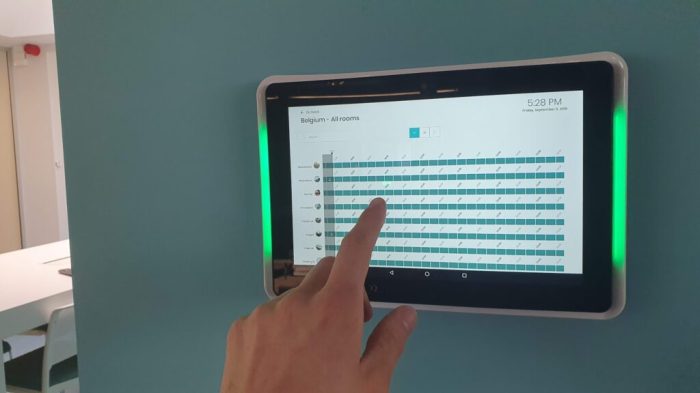Meeting room reservation software is revolutionizing how businesses manage their meeting spaces. Efficient scheduling, reduced conflicts, and improved resource utilization are just some of the benefits this technology offers. Imagine a world where finding an available room is as simple as a few clicks, eliminating the frustrating back-and-forth emails and phone calls. This software makes that a reality, offering a range of features designed to optimize workplace productivity and collaboration.

Source: behance.net
From simple calendar-based systems to sophisticated platforms integrating with other office tools, the options available cater to businesses of all sizes and complexities. These systems often include features such as real-time availability displays, booking confirmations, and even integration with video conferencing technologies, creating a seamless and efficient meeting experience from start to finish.
In today’s dynamic work environment, efficient meeting scheduling is paramount. The days of scrambling for available rooms, double-bookings, and wasted time are thankfully fading thanks to the rise of meeting room reservation software. This comprehensive guide delves into the intricacies of this technology, exploring its features, benefits, and how it can transform your workplace productivity. We’ll cover everything from choosing the right software to maximizing its potential, ensuring you’re equipped to make an informed decision.
Understanding the Need for Meeting Room Reservation Software
Before diving into the specifics, let’s establish why meeting room reservation software is crucial for modern businesses. Traditional methods, such as whiteboards or shared spreadsheets, are often prone to errors, leading to scheduling conflicts and lost productivity. These manual systems lack the real-time updates and centralized management that efficient scheduling demands. The consequences can include:
- Wasted time: Employees spend valuable time searching for available rooms, leading to delays and frustration.
- Double bookings: Overlapping meetings disrupt workflows and create logistical nightmares.
- Inefficient resource utilization: Meeting rooms may sit empty while others scramble for space.
- Lack of transparency: Employees lack a clear overview of room availability, hindering effective planning.
- Poor communication: Misunderstandings and missed meetings arise from outdated or inaccurate scheduling information.
Meeting room reservation software addresses these challenges by providing a centralized, real-time system for managing meeting room bookings. This ensures transparency, reduces conflicts, and optimizes resource utilization, ultimately boosting overall productivity and employee satisfaction.
Key Features of Effective Meeting Room Reservation Software
The best meeting room reservation software offers a range of features designed to streamline the scheduling process. These features can vary depending on the specific software, but some common and essential elements include:
Real-time Availability
This core feature displays the current availability of each meeting room in real-time, eliminating the guesswork and potential for double-bookings. Users can instantly see which rooms are booked and when, allowing for quick and accurate scheduling.
Calendar Integration
Seamless integration with popular calendar applications (like Google Calendar, Outlook, etc.) allows users to manage their meetings from a single platform. This eliminates the need to switch between different applications, simplifying the scheduling process.
Booking Management
Effective software allows for easy booking, modification, and cancellation of meeting room reservations. This ensures flexibility and control over the scheduling process.
Resource Management (Beyond Rooms)
Many advanced systems go beyond simple room booking, allowing for the reservation of other resources like equipment (projectors, whiteboards, etc.), catering services, or even parking spaces. This centralized resource management streamlines event planning.
User Access Control
Robust security features ensure that only authorized personnel can access and manage bookings. This prevents unauthorized access and maintains data integrity.
Reporting and Analytics
Data-driven insights into meeting room usage patterns provide valuable information for optimizing space allocation and resource management. This allows for data-backed decisions to improve efficiency.
Mobile Accessibility
The ability to access and manage bookings from mobile devices enhances flexibility and allows for on-the-go scheduling.
Notifications and Reminders, Meeting room reservation software
Automated notifications and reminders ensure that users are kept informed of their upcoming meetings and prevent missed appointments.
Choosing the Right Meeting Room Reservation Software
Selecting the right software involves careful consideration of your specific needs and budget. Here are some key factors to consider:
- Number of meeting rooms: Choose software that can handle the number of rooms you need to manage.
- Scalability: Consider the software’s ability to adapt to your future needs as your organization grows.
- Integration capabilities: Ensure compatibility with your existing calendar systems and other workplace tools.
- User-friendliness: The software should be intuitive and easy to use for all employees.
- Customer support: Reliable customer support is crucial for resolving any issues that may arise.
- Pricing model: Compare different pricing plans to find the best value for your budget.
- Security features: Prioritize software with robust security measures to protect sensitive data.
Benefits of Implementing Meeting Room Reservation Software
The advantages of adopting meeting room reservation software extend beyond simple scheduling. The benefits include:
- Increased productivity: Reduced scheduling conflicts and wasted time lead to significant productivity gains.
- Improved resource utilization: Optimal allocation of meeting rooms ensures that space is used efficiently.
- Enhanced communication: Real-time updates and notifications improve communication and coordination.
- Cost savings: Reduced wasted time and improved resource utilization translate to cost savings.
- Better employee satisfaction: A streamlined scheduling process reduces frustration and improves morale.
- Data-driven insights: Reporting and analytics provide valuable data for optimizing workplace efficiency.
Frequently Asked Questions (FAQ)
- Q: Is meeting room reservation software expensive? A: The cost varies depending on the features and the number of users. Many providers offer different pricing tiers to suit various budgets.
- Q: How easy is it to integrate with my existing calendar? A: Most reputable software integrates seamlessly with popular calendar applications like Google Calendar and Outlook.
- Q: What if there’s a technical problem? A: Reputable providers offer reliable customer support to address any technical issues promptly.
- Q: Can I customize the software to fit my company’s needs? A: Many platforms offer customization options, allowing you to tailor the software to your specific requirements.
- Q: Is my data secure? A: Reputable providers prioritize data security with robust measures to protect sensitive information.
- Q: What if I need to cancel a meeting? A: Most systems allow for easy cancellation of bookings, often with notification options to attendees.
Conclusion: Embrace the Future of Meeting Room Management
Meeting room reservation software is no longer a luxury; it’s a necessity for any organization striving for efficiency and productivity. By implementing a robust system, businesses can significantly reduce wasted time, improve resource utilization, and enhance overall workplace effectiveness. Take the leap and experience the transformative power of streamlined meeting management.

Source: fullonapp.com
References
While specific software recommendations are avoided to maintain impartiality, researching reputable software review sites and vendor websites is crucial for informed decision-making. Consider looking at reviews on sites like G2, Capterra, and Software Advice.
Call to Action
Ready to optimize your meeting room scheduling and boost your team’s productivity? Explore the available options today and find the perfect meeting room reservation software for your organization! Start your free trial or request a demo now!
Ultimately, the adoption of meeting room reservation software signifies a significant step towards a more organized and productive work environment. By centralizing scheduling and providing clear visibility into room availability, these systems eliminate common scheduling headaches and empower employees to focus on their core tasks. The result is a more efficient use of resources, improved collaboration, and a smoother overall workflow, leading to enhanced productivity and a more positive work experience.
Common Queries
What are the typical costs associated with meeting room reservation software?
Costs vary widely depending on the features, scalability, and vendor. Expect a range from free, basic options for smaller teams to subscription-based models with varying pricing tiers for larger organizations and advanced features.
How does the software integrate with my existing calendar system?
Most reputable software integrates seamlessly with popular calendar platforms like Google Calendar, Outlook, and Exchange. Check the specific software’s compatibility before purchasing.
What security measures are typically included?
Security features vary, but reputable providers offer robust security protocols including data encryption, access controls, and user authentication to protect sensitive scheduling information.
Can the software handle multiple locations or offices?
Many platforms support multiple locations, allowing centralized management of meeting rooms across different offices or buildings. This capability is often a key feature for larger organizations.
